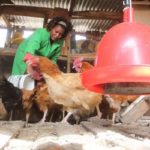I have been raising poultry, primarily kienyeji chicken, since 2014 and I plunged into the industry with zero knowledge about chickens. So I had to literally learn on the job, incur some losses and build some experience over the years. One of the ways I mitigated losses and reduced the difficulty level in raising poultry was by totally avoiding the day old chicks. I would let a more experienced farmer raise them to six weeks or 2 months and then purchase them at that age.
That has its advantages and disadvantages. The risk of mortality is significantly reduced at that age and there is less intensive management required for the young chicks. The disadvantage is that at that age, the chicks are already too costly, typically going for between Ksh.250 and Ksh.300 from my local farmer. Considering I still have to feed them for another 3 months before they are ready for market, my margins are often significantly reduced. If you manage to just put in some good management and sell them in my time, I am still operating on the edge of the margins. It is a close shave and you only make good money if keep a huge number of them.
If you can manage the management headache, starting from day old chicks can be cheaper over the long run. To obtain good results during the first 7 days in the lives of your day old chicks, you have to get 5 factors right. These include:-
- Feed
- Water
- Oxygen
- Light
- Temperatures
Feed
This is the most essential ingredient required to achieve results for your day old chicks. Not only should you provide the right feed in the right amounts, but the feed should also be optimally positioned in the chicken shed to prevent overcrowding and for easy access.
In order for your chicks to be well fed during the first few days so that they can have proper growth, ensure that the heights of feeders and drinkers used are neither greater nor lower than the height of the backs of the chickens. The feeders and drinkers should not be put closely together but at proportionate distances each other so they can feed and drink comfortably.
Water
Chickens will never “forgive” you for insufficient water supply. Ensure that they are provided with fresh and clean drinking water at all times.
Oxygen
The poultry house must be well aerated and well ventilated. A stuffy chicken shed will likely cause various health conditions due to the accumulation of dust and gases such as ammonia. Avoid closing all vents in the poultry house so as to compensate for heat. Just like humans, chickens also need lots of fresh air to breathe. If you will be using charcoal to heat your poultry house, you should keep in mind that the charcoal will eat up the oxygen and you must therefore provide adequate ventilation in the kienyeji chicken house.
Light
Lighting is very key to optimal poultry performance, even in kienyeji chickens. Chickens can’t eat in the dark. They need the light to access the feeding troughs and drinkers. Natural lighting is the best but if you are planning to hang lamps in your poultry house, make sure that the lamps are of the right height so as to illuminate over a wide area. It is also advisable to implement an optimal lighting program for your poultry as this will stimulate feeding, leading to greater productivity.
